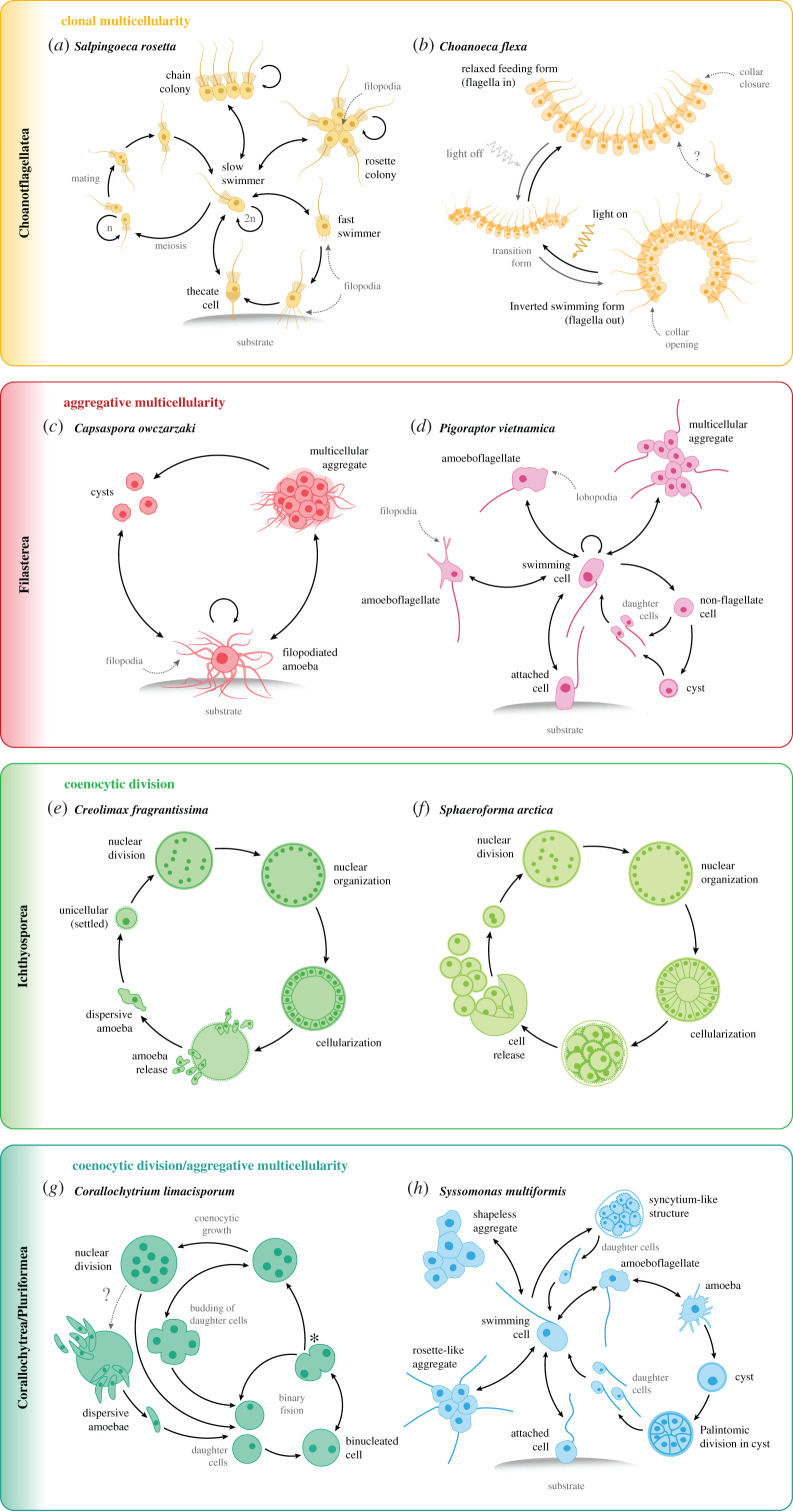Figure 3.
Temporally alternating life cycles of unicellular holozoans. Each panel shows life stage transitions of two unicellular holozoan species representing each clade. Arrows indicate directionality of the transition. Loop arrows indicate cell division. Dotted arrows with question marks between stages indicate potential (unconfirmed) life-stage transitions. (a) Life stages of the colonial choanoflagellate Salpingoeca rosetta [176,187]. The asexual life cycle (on the right) includes a single-celled sessile thecate stage (adhered to the substrate), slow and fast swimming single-celled stages, and two types of clonal colonial stages (chain and rosette colonies), in which neighbouring cells are linked by intercellular bridges [188–190]. Starvation triggers the S. rosetta sexual cycle (on the left), in which diploid cells (slow swimmers) undergo meiosis and recombination, and the resulting haploid cells (which can also divide asexually) mate anisogamously [176,178]. (b) Life stages of the colonial choanoflagellate Choanoeca flexa [96]. Light-to-dark transitions induce C. flexa colonies to rapidly and reversibly invert their curvature while maintaining contacts among neighbouring cells between their collar microvilli, alternating between two colony conformations. In response to light, colonies exhibit a relaxed (flagella-in) feeding form. In the absence of light, colonies transition to an inverted (flagella-out) swimming form. (c) Life stages of the filasterean Capsaspora owczarzaki [64,65,98]. In the trophic proliferative (filopodial) stage, cells are amoebae adhered to the substrate, extending several long, thin actin-based filopodia. These amoebas can detach from the substrate and actively aggregate in the aggregative or ‘multicellular’ stage, producing an extracellular matrix that presumably binds them together. In response to crowding or stress, cells from both the amoeba and the aggregative stages can encyst by retracting the filopodia into a cystic or resistance stage. (d) Putative life stages of the filasterean Pigoraptor vietnamica [26,70]. Swimming flagellated cells can form long, thin, sometimes branching filopodia that can attach to the substrate. Flagellated cells can sometimes present wide lobopodia. Flagellated cells can retract the flagellum and become roundish, to either divide into two daughter flagellated cells or transition to a cystic stage. This can, in turn, produce two flagellated daughter cells. Cells can also form easily disintegrating aggregations of cells and feed jointly. The life stages of Pigoraptor chileana are very similar to the ones of P. vietnamica, but P. chileana shows a much reduced capability to produce filopodia and lobopodia (both stages are extremely rare in P. chileana). (e) Life stages of the ichthyosporean Creolimax fragrantissima [45,77]. Single-nucleated amoebae disperse until they settle and encyst. The rounded cell undergoes multiple rounds of synchronous nuclear division (coenocytic division) without cytoplasmic division. Nuclei are later arranged at the periphery of the cell as a large central vacuole grows. Finally, the coenocyte cellularizes and new amoebas are released to start the cycle over again. (f) Life stages of the ichthyosporean Sphaeroforma arctica [99,180]. Single-nucleated cells undergo multiple rounds of synchronous nuclear division (coenocytic division) without cytoplasmic division. Nuclei are later arranged at the periphery of the cell. Finally, the coenocyte cellularizes, releasing a number of daughter cells to start the cycle over again. (g) Life stages of the corallochytrean Corallochytrium limacisporum [22,83,191]. Reproduction in C. limacisporum occurs mainly through binary fission (99% of the cases), during which a binucleated cell divides into two, symmetrical, uninucleate cells. Binucleate cells can form two lobes that can lead to cellular division (forming two monoucleate cells), or can reverse towards spherical cells. At this point (*), cells can transition to coenocytic growth (1% of the cases) and continue dividing their nuclei further forming quadrinucleated cells. Quadrinucleated cells can often form a clover-like shape (similar to bilobed cell), that generates either four mononucleate cells or returns to spherical shape and further divides to an eight, 12 and up to 32 nuclei coenocyte. Coenocytes can release dispersive amoebas to start the cycle over again. (h) Putative life stages of the pluriformean Syssomonas multiformis [26,70]. A swimming flagellated cell can temporarily attach to the substrate through the anterior part of the cell body or move to the bottom and transform to an amoeboflagellate form by producing both wide lobopodia and thin short filopodia. Flagellated cells can lose the flagellum via different modes and transition into an amoeba stage, which produces thin, relatively short filopodia. Both amoeboflagellate and amoeba stages can transition back to the flagellate stage. Amoeboid cells can also encyst by retracting their filopodia and rounding the cell body. Palintomic divisions may occur in the cystic stage to release several flagellated daughter cells. Flagellated cells can partially merge and form temporary shapeless cell aggregates of both flagellated or non-flagellated cells and rosette-like colonies composed by only flagellated cells (showing outwards-directed flagella). In rich medium, solitary flagellated cells can sometimes actively merge and form a syncytium-like structure, which undergoes budding and releases flagellated daughter cells.

